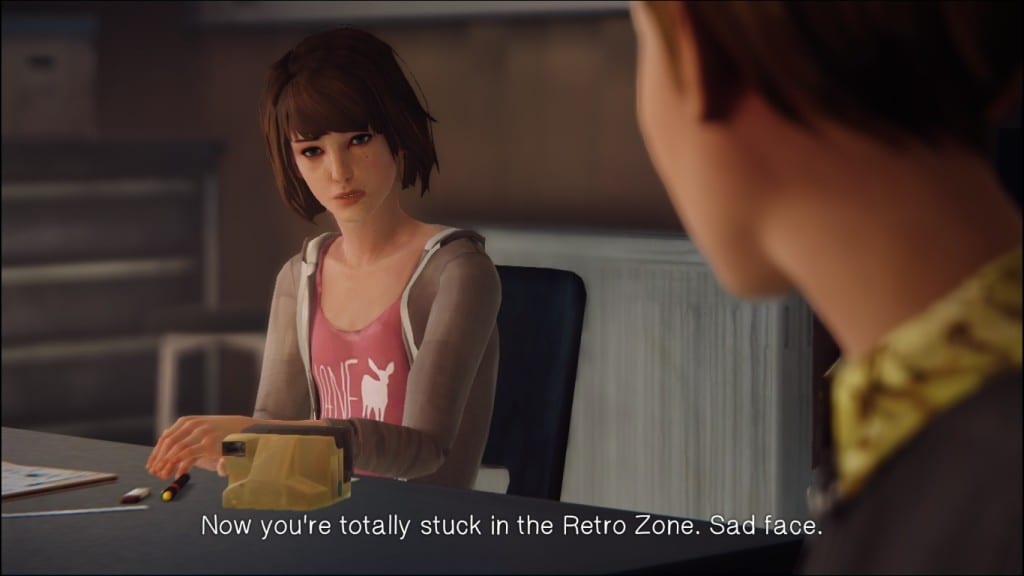Life is a tornado. What can you do to stop it?
Photography. Indie music. An academy for youngsters, including a particularly, er, “gifted” one.
No, this isn’t some hipster spinoff of X-Men.
It’s the setting for Life is Strange, developed by Dontnod Entertainment and published by Square-Enix. Life is Strange follows the story of Max Caulfield, an 18-year-old girl who left her hometown of Arcadia Bay, Oregon, to move to Seattle, only to return later after being accepted to Blackwell Academy. Max is a little bit of a lonely girl, having left her best friend Chloe when she moved to Seattle, and subsequently she left her Seattle friends behind to return to Arcadia. While she knows her classmates, she mainly hangs onto her camera, and is in a class taught by renowned photographer Mark Jefferson.
Max begins to have a panic attack after class one day, and hides in the restroom.
And then she realizes she can rewind time.
Gifted.
From there, the story takes a turn for the dark, bringing in a missing classmate, visions of storms, and strange circumstances surrounding multiple characters, including Max’s best friend Chloe. It’s Veronica Mars meets Gone Home with a dash of the supernatural, and it hooked me pretty quickly.
The game itself is pretty simple. Players control Max, who is able to walk around and examine much of her surroundings as well as talk to the people around her. She has a journal that recaps previous events in the game, and upon completion, keeps track of the choices that were made. It’s almost like the episodic Walking Dead games by Telltale, and reminiscent of old point-and-click adventure games in how detailed it can be and how much stuff can be examined. Adding in the time-travel mechanic, though, gives it another bit of depth; it’s used to solve puzzles, to reverse decisions that might change the course of the game, and even to move around blocked pathways. The time-travel doesn’t affect Max herself, though, allowing her to hold onto items or thoughts she’d had in different timelines. It’s a cool mechanic, and I find myself planning on replaying the game multiple times to see how different decisions affect what goes on–the game tells you when something may have consequences, but doesn’t hint at exactly what those might be. That being said, though, because this is just the first of five parts, most of these ramifications don’t seem to come into play just yet.

The game itself is gorgeous. It’s somewhat cel-shaded, reminding me–again–of work that Telltale Games has done in the past, without ever looking like a ripoff. Character body types all differ, which is wonderful, and there’s a nice, diverse cast, although so far the main players all seem to be white. There are possible hints at queer characters, too, which I hope will come into play as it goes further. The environments are well-done for such a small game; trees sway in the wind, and the game’s opening is appropriately chaotic given the circumstances of it. Even the time-travel mechanic is done well, looking like overexposed photos as you rewind further. Musically, too, the game just works. It uses soft indie rock as a way for Max to tune out the outside world, and sets the tone really well.
Unfortunately, I can’t say the same for the dialogue. While the voice acting is great for the most part–Max sounds appropriately shy, and Chloe sardonic, not to mention she’s voiced by Ashly Burch of Hey Ash, Whacha Playin’? fame–the things that come out of their mouths are passable at best and try-hard at worst. It’s frustrating, because there are times where it’s really true-to-life, but then other times where the dialogue sounds like someone attempting to emulate what they think teenagers sound like, rather than actually doing so. Chloe in particular often uses “hella” in strange places, and artists and photographers are name-dropped so often it feels like an attempt to appeal to people rather than an actual setting. With any luck, the writing will get better as the series goes on, because the premise and characterization are well-done.

It should also be noted that it’s not just the dialogue hampering Life is Strange: on my playthrough, I had quite a few voice glitches, with characters stammering and restarting their sentences every couple of seconds, and the voice acting didn’t match the lip-sync. I’ve heard from friends the former problem isn’t present on the Playstation 4 version, so I’m hoping it’s just an issue of my computer’s specs more than anything else.
Even with its issues, though, I found Life is Strange compelling. With a diverse cast of characters, an intriguing time-travel mechanic, and several mysteries to solve at its center, the game does a great job of pulling players in. I just wish I didn’t have to wait for each episode; Chrysalis was clearly just the introduction, and I can’t wait to see what else Dontnod has in store.
Good
-compelling mysteries
-cool time-travel mechanic
-stylistic choices make the game look great
-a myriad of choices that will affect the game later on
Bad
-voice acting doesn’t match lip-sync
-dialogue comes across as try-hard rather than authentic
-only the beginning, giving only a slight taste of what’s to come
-choices don’t seem to affect much just yet
Play it if: you’re looking for an intriguing adventure game and have patience for iffy dialogue and episodic releases.
Life is Strange was given to me as a gift; I plan on buying the full game again for Playstation 4. Episode 1 took approximately 3 hours to complete. It’s available on Steam for $4.99USD, as well as on Playstation 3, Playstation 4, Xbox 360, and Xbox One. Episode 2 will be released in March 2015.

